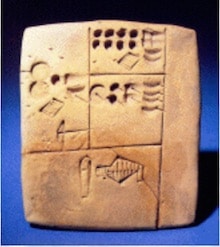Five Question Quiz on the History of Audiology
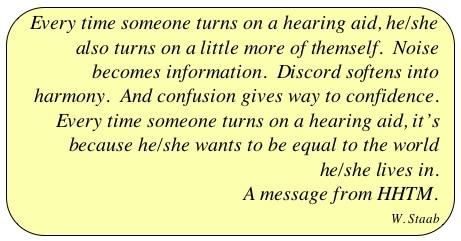 A number of hearing professionals have commented to me that many current hearing personnel appear to have little knowledge of the history of audiology, especially of individuals and the events that founded what we have become. Here is your chance to prove them wrong. (Answers follow after the questions).
A number of hearing professionals have commented to me that many current hearing personnel appear to have little knowledge of the history of audiology, especially of individuals and the events that founded what we have become. Here is your chance to prove them wrong. (Answers follow after the questions).
- The history of audiology is based on scientific roots in the 1800s. Which of the following was considered a key figure, if not the inventor of psychophysics?
- Hermann Ludwig Ferdinand von Helmholtz
- S.S. Stevens
- Gustav Theodor Fechner
- Georg von Békésy
- Harvey Fletcher
- From 1940 to about 1962, one of the following locations was the leader in research on the scientific foundation of the physics of sound, anatomy/physiology of the auditory system, and testing methods:
- NBS (National Bureau of Standards)
- Bell Telephone Laboratories
- Northwestern University
- NAL (National Acoustic Laboratory)
- PAL (Psycho-Acoustics Laboratory)
- The evolution of the clinical foundation of audiology is generally attributed to:
- Hallowell Davis
- Raymond Carhart
- C.C. Bunch
- Ira Hirsh
- Richard Silverman
- The author of Hearing and Deafness: A Guide for Laymen, written in 1947, was:
- Louise Tracy
- Helmer Myklebust
- Raymond Carhart
- Norton Canfield
- Hallowell Davis
- The first audiology academic program in the United States was founded where?
- City University of New York
- Harvard University
- Northwestern University
- The University of Illinois
- Central Institute for the Deaf
Answers
- Gustav Theodor Fechner
 Gustav Theodor Fechner was born in a village in western Poland (Gross-Särchen in Lower Lusatia) close to the German Border in 1801. He was educated first at Sorau, and in 1817 studied medicine in Dresden, and then in the biological sciences and psychology at the University of Leipzig, starting in 1818. He remained in Leipzig the remainder of his life. In addition to being a psychologist, he was considered a philosopher, physicist, mathematician, and early pioneer in experimental psychology. He is considered a key figure, if not the founder, of Psychophysics (the science studying the quantitative relations between sensations and the stimuli that produce them).
Gustav Theodor Fechner was born in a village in western Poland (Gross-Särchen in Lower Lusatia) close to the German Border in 1801. He was educated first at Sorau, and in 1817 studied medicine in Dresden, and then in the biological sciences and psychology at the University of Leipzig, starting in 1818. He remained in Leipzig the remainder of his life. In addition to being a psychologist, he was considered a philosopher, physicist, mathematician, and early pioneer in experimental psychology. He is considered a key figure, if not the founder, of Psychophysics (the science studying the quantitative relations between sensations and the stimuli that produce them).
The Encyclopaedia Britannica describes Fechner’s contributions as follows:
Fechner’s Elemente der Psychophysik, 2 vol. (1860; Elements of Psychophysics), established his lasting importance in psychology. In this work he postulated that mind and body, though appearing to be separate entities, are actually different sides of one reality. He also developed experimental procedures, still useful in experimental psychology, for measuring sensations in relation to the physical magnitude of stimuli. Most important, he devised an equation to express the theory of the just-noticeable difference, advanced earlier by Ernst Heinrich Weber. This theory concerns the sensory ability to discriminate when two stimuli (e.g., two weights) are just noticeably different from each other. Later research has shown, however, that Fechner’s equation is applicable within the midrange of stimulus intensity and then holds only approximately true.
- Psycho-Acoustic Laboratory
The Psycho-Acoustic Laboratory (PAL) was established at Harvard University in 1940. It was the largest university-based program of wartime psychological research. Its purpose was to conduct research in speech, hearing, and communications during World War II. Following the war, it continued to operate, and was renamed the Laboratory of Psychophysics in 1962.
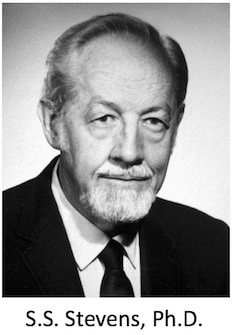 PAL was headed by Dr. S.S. “Smitty” Stevens, a Harvard graduate specializing in auditory psychophysics. He had been told early in his faculty position that he could be expected to be an Assistant Professor, permanently{{1}}[[1]]Capshew, J.H. 1999. Psychologists on the March: Science, Practice, and Professional Identity in America, Cambridge University Press[[1]].
PAL was headed by Dr. S.S. “Smitty” Stevens, a Harvard graduate specializing in auditory psychophysics. He had been told early in his faculty position that he could be expected to be an Assistant Professor, permanently{{1}}[[1]]Capshew, J.H. 1999. Psychologists on the March: Science, Practice, and Professional Identity in America, Cambridge University Press[[1]].
PAL and EAL
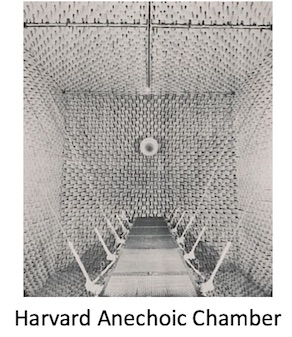 Further enabling the research of PAL was a tandem program at Harvard called the Electro-Acoustic Laboratory (EAL), headed by physicist Leo Beranek. The two laboratories coordinated their efforts to identify and understand the psychological and physical problems related to the management of noise.
Further enabling the research of PAL was a tandem program at Harvard called the Electro-Acoustic Laboratory (EAL), headed by physicist Leo Beranek. The two laboratories coordinated their efforts to identify and understand the psychological and physical problems related to the management of noise.
Additional PAL alumni who ended up with distinguished careers were George Miller, J.C.R. Licklider, Karl D. Kryter, and Ira Hirsh.
- C.C. Bunch, Ph.D.
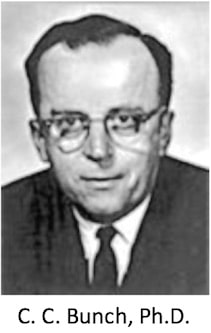 The first genuine audiologist in the United States was undoubtedly Cordia C. Bunch{{2}}[[2]]Jerger, J. 2009. Audiology in the USA, P. 6, Plural Publishing, San Diego[[2]]. A graduate of the University of Iowa, and influenced by Carl Seashore, he developed the first audiometer, called the “pitch range audiometer.” Measuring threshold and discomfort levels from 30 to 10,000 Hz, he plotted the “hearing field” of patients. He moved on to Johns Hopkins and then to Washington University School of Medicine in St. Louis, MO where he continued air-conduction data collection for twenty years. In 1943 he published Clinical Audiometry, a book that reflected his pioneering systematic studies of the relationship between hearing loss and audiometric patterns.
The first genuine audiologist in the United States was undoubtedly Cordia C. Bunch{{2}}[[2]]Jerger, J. 2009. Audiology in the USA, P. 6, Plural Publishing, San Diego[[2]]. A graduate of the University of Iowa, and influenced by Carl Seashore, he developed the first audiometer, called the “pitch range audiometer.” Measuring threshold and discomfort levels from 30 to 10,000 Hz, he plotted the “hearing field” of patients. He moved on to Johns Hopkins and then to Washington University School of Medicine in St. Louis, MO where he continued air-conduction data collection for twenty years. In 1943 he published Clinical Audiometry, a book that reflected his pioneering systematic studies of the relationship between hearing loss and audiometric patterns.
- Hallowell Davis, M.D.
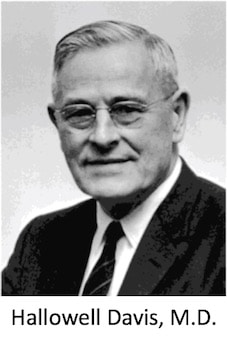 Most individuals are familiar with a book having a similar title, Hearing and Deafness, published in 1960 and co-edited with S. Richard Silverman. However, few are familiar with Hearing and Deafness: A Guide for Laymen, written and edited by Hallowell Davis alone, in 1947. It had eight printings through 1955. The 1947 version evolved into the 1960 and 1970 versions that most are familiar with.
Most individuals are familiar with a book having a similar title, Hearing and Deafness, published in 1960 and co-edited with S. Richard Silverman. However, few are familiar with Hearing and Deafness: A Guide for Laymen, written and edited by Hallowell Davis alone, in 1947. It had eight printings through 1955. The 1947 version evolved into the 1960 and 1970 versions that most are familiar with.
Hearing and Deafness: A Guide for Laymen, was edited by Hallowell Davis, with most chapters prepared by specialists in other fields: E.P. Fowler, T.E. Walsh, S.R. Silverman, Gordon Taylor, M.D. Pauls, R. Carhart, N. Canfield, L.E. Morrissett, H.S. Lane, D.A. Ramsdell, B.C. Wright, A.M. Hill, and H.R. Myklebust. The authors read and criticized each other’s chapters.
The book was written initially as a guide for laymen who were personally interested in their hearing impairment and how it could be treated. This, now referenced as the “first edition”, served its purpose well, but unexpectedly served another purpose as well – that as a textbook for students in the new academic discipline of audiology. The second edition had less emphasis on the needs of the individual to understand his hearing loss and how to use hearing aids, and provided greater emphasis on the basic sciences. The third edition expanded into acoustics, psychoacoustics, neurophysiology, genetics, audiometry, the handicaps of hearing, the education of deaf children, emphasis on social problems, and government involvement with education and the handicapped. Some of the same authors from the first and second editions wrote for the third edition as well.
- Northwestern University
Northwestern University was the first in the US to offer a course for audiologists. The course was taught by Dr. Raymond Carhart in 1946. The discipline of audiology, and the term itself, was born earlier in 1939 in addressing hearing damage of World War II veterans by Stanley Nowak, a distributor of hearing aids{{3}}[[3]] https://findingaids.library.northwestern.edu/catalog/inu-ead-nua-archon-662[[3]].
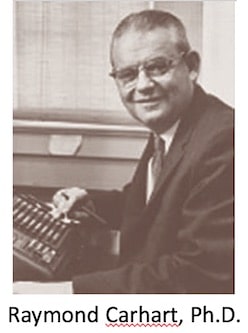 Northwestern University’s origin leading to this first course in audiology was from a Program in Education of the Deaf and Hard of Hearing that started in 1941, and then incorporated into a budding program in speech correction in 1942. Carhart was hired to teach the first course in audiology in 1946, replacing C.C. Bunch who was originally scheduled to teach the course, but who had passed away. Dr. Carhart had spent 1944 at Deshon Army Hospital in Pennsylvania, working with veterans
Northwestern University’s origin leading to this first course in audiology was from a Program in Education of the Deaf and Hard of Hearing that started in 1941, and then incorporated into a budding program in speech correction in 1942. Carhart was hired to teach the first course in audiology in 1946, replacing C.C. Bunch who was originally scheduled to teach the course, but who had passed away. Dr. Carhart had spent 1944 at Deshon Army Hospital in Pennsylvania, working with veterans
The impetus for teaching audiology at Northwestern University came immediately after the war when the Veteran’s Administration appointed Northwestern as the first of several agencies in the US to assist in the speech rehabilitation of war veterans.
Even though the Northwestern University course was the first in audiology, Carhart noted “The University of Illinois has the distinction of having made the first academic appointment in Audiology while Northwestern University is the first school to establish and maintain an educational program in Audiology.”
Dr. Carhart was promoted to Professor of Audiology in 1947 with an indefinite tenure. In 1953 he was named Head of the Audiology Program and held that post until his death in 1975.
Notes: Most of this information is from the Northwestern University Library Archival and Manuscript Collections, Guide to the Records of the Department of Audiology. The author of this post has an original copy of Hearing and Deafness: A Guide for Laymen.



